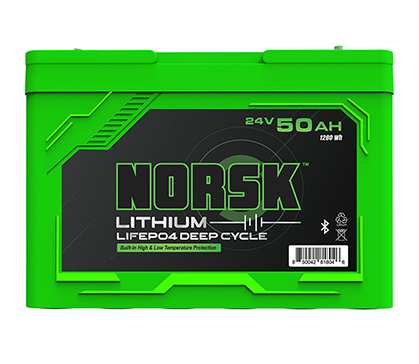How to Make Trolling Motor Batteries Last Longer?
Trolling motor batteries are the powerhouse of your boat’s trolling system, providing the power to navigate through fishing hotspots quietly and efficiently. However, like any battery, they have a finite lifespan, and their longevity depends on proper care and maintenance.
By learning how to make trolling motor batteries last longer, you can maximize your investment and enjoy uninterrupted fishing adventures on the water.
Importance of Maintaining Trolling Motor Batteries
Keeping your trolling motor batteries in good condition ensures reliable performance and extends their life. Proper maintenance helps prevent unexpected failures and costly replacements. Here’s why maintaining your trolling motor batteries is essential:
- Lifespan. A well-maintained trolling motor battery can last for several seasons. Neglecting your batteries can lead to premature failure, forcing you to replace them more frequently.
- Performance. Properly maintained batteries deliver consistent and reliable power, allowing you to troll longer and farther without worrying about your motor losing juice. Neglected batteries lose capacity and struggle to provide the power your trolling motor needs.
- Safety. A failing battery can leave you stranded on the water, potentially putting you in a dangerous situation, especially if you’re far from shore or encounter unexpected weather changes. Regular maintenance helps identify potential issues before they escalate.
Selecting the Right Trolling Motor Battery
The first step to maximizing battery life is choosing the correct battery for your needs. Here are some factors to consider when selecting your trolling motor battery:
- Boat size and trolling motor power. Generally, larger boats with stronger motors require batteries with higher amp-hour (Ah) ratings to ensure they can handle extended trolling sessions. For example, a 100Ah battery can deliver 1 amp for 100 hours or 10 amps for 10 hours.
- Battery type. There are three main types of trolling motor batteries. Lead-acid wet cell batteries are affordable and handle frequent discharge and recharge cycles well. However, they require regular maintenance, such as checking water levels and cleaning terminals to prevent corrosion.
- Choosing the right voltage. Most trolling motors are 12-volt systems. However, some require 24 or even 36 volts, which can be achieved by connecting multiple batteries in series or parallel configurations. Ensure your battery selection matches your trolling motor's voltage requirements.
- Charging time. Lithium batteries generally recharge up to four times faster than lead-acid and AGM batteries, minimizing downtime between fishing trips. This is an important consideration if you like to fish multiple times a day or spend extended periods on the water.
Absorbed Glass Mat (AGM) batteries are sealed and maintenance-free, making them convenient. They typically have a slightly longer (3 to 4 years) lifespan than lead-acid wet cell batteries but come at a higher price point.

Finally, while more expensive, lithium-ion batteries offer superior performance, longer life cycles (up to 10 years), and lighter weight. They are also maintenance-free and environmentally friendly.
Optimizing the Life of Your Trolling Motor Battery
Following best practices to maximize your trolling motor battery’s performance is important. Here are some key strategies to optimize battery life:
- Proper charging practices. Maintaining the correct charging routine can extend your battery’s life. After allowing the battery to cool to avoid heat buildup, fully recharge your battery as soon as possible after use to prevent sulfation buildup (when crystals form on the negative plate).
If you notice crystal development, try equalizing the charge to balance the cells. Many chargers offer this function, and it can also help prevent stratification (when the acid concentration is higher at the bottom of the battery.)
If you plan to store your trolling battery for a long time, consider using a trickle charger during the off-season. This will help maintain a proper charge level.
FISH307 offers a range of high-quality battery chargers from top brands like Dolphin and Dual Pro, designed specifically for trolling motor batteries. These chargers feature advanced charging algorithms and safety features to ensure optimal charging and prevent overcharging, which can damage the battery.
- Effective usage habits. How you use your trolling motor battery can affect its lifespan. Understand your battery’s capacity and plan your usage time to avoid deep discharges. Additionally, matching your battery’s discharge rate with the motor’s power requirements can ensure optimal performance.
Operate your trolling motor in calm waters to reduce power consumption whenever possible. Otherwise, you can balance the load and energy consumption by adjusting your trolling speed and gradually charging it to conserve battery power.
- Regular maintenance. Routine maintenance ensures your trolling motor battery operates at peak performance and lasts as long as possible. Always visually inspect your battery for signs of damage, such as bulging, cracking, or corrosion on the terminals.
Cleaning the battery and terminals helps prevent corrosion buildup, which can impede electrical connections. Check water levels for lead-acid wet cell batteries and top up with distilled water as needed. Performing voltage and specific gravity tests can help identify issues like over-watering or inadequate charging, ensuring your battery remains in top condition.
Common Mistakes That Shorten Battery Life
While following best practices can extend your trolling motor battery’s lifespan, inevitable mistakes can also reduce its life expectancy and potentially compromise your safety on the water.

- Overcharging the battery. Overcharging can lead to excessive heat buildup within the battery, causing the electrolyte to dry out or, in severe cases, rupture or catch fire. Always use the appropriate charger and follow the manufacturer’s instructions.
- Allowing the battery to drain completely. Deep discharges, where the battery is drained to a critically low level, can cause sulfation buildup on the battery plates, reducing capacity and performance. Avoid letting your battery drain completely before recharging.
- Ignoring warning signs of damage. If your battery shows signs of damage, such as bulging, cracking, or leaking, address the issue promptly. Continuing to use a damaged battery can be dangerous and may lead to complete failure.
Troubleshooting Trolling Motor Battery Issues
Even with proper care and maintenance, trolling motor batteries can encounter issues that require troubleshooting. Addressing these problems promptly can prevent further damage and extend your battery’s life.
- Reduced runtime. If your trolling motor battery doesn’t last as long as it used to, sulfation buildup might be the cause. Over time, sulfation can accumulate on the battery plates, reducing capacity and runtime. Performing regular equalization charges can help mitigate this issue. Loose battery terminals or cable connections can also cause high resistance, limiting the flow of electricity and reducing performance.
Additionally, their internal components degrade as batteries age, leading to reduced capacity and runtime. If your battery is nearing the end of its expected lifespan, replacement may be necessary.
- Charging issues. When a trolling motor battery has trouble holding a charge or charging properly, damaged cells might be the cause. Internal damage to the battery cells, often caused by overcharging or deep discharges, can prevent proper charging.
Faulty charging systems, such as a malfunctioning charging algorithm or outdated technology, can also lead to improper charging and reduced battery life.
- Leaks or swelling. Leaks or swelling in your trolling motor battery are signs of internal damage and potential safety hazards. Leaks indicate a cracked or damaged battery case, while swelling is often caused by excessive gas buildup within the battery. In either case, discontinue use immediately and replace the battery to prevent further damage or potential fire hazards.
When troubleshooting battery issues, consult the manufacturer’s guidelines or seek professional assistance if unsure about the cause or appropriate solution. Attempting to repair or continue using a damaged battery can be dangerous and may exacerbate the problem.
Extend the Life of Your Trolling Motor Batteries
Don’t let a dead battery ruin your fishing adventures. Learn how to make trolling motor batteries last longer with FISH307 by contacting us today to connect with our team of experienced anglers.
We offer top-quality trolling motors, chargers, and accessories, along with professional advice on maintenance and troubleshooting. Explore our selection today to optimize your trolling system so you can spend more time on the water.
Recent Posts
-
Ice Fishing Safety 101: What Every Angler Needs To Know
Ice fishing offers a unique thrill, but safety should always come first. Knowing the basics of ic
-
Ice Fishing Season Prep: Your Essential Pre-Ice Checklist
When the lakes start freezing, it’s time to swap your boat for an ice auger. But before you hit the




